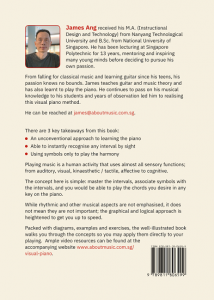Many people are familiar with the C key on piano, but fret when it comes to other keys. At the core of the Visual Piano is the ease with which one finds in playing any keys – black or white on the keyboard.
The distinctive patterns on the piano are actually much easier (to perceive) than most people thought.
In this book, you will find the key to free yourself from the fear of playing unfamiliar keys.
Here you will find a foolproof method to transpose accurately in any key. You will be able to play your favourite tunes in any key you like.
From the Introduction of the Book:
Many people can play tunes in C Major on the piano but will struggle to play the same tune in other keys. It does not help if they can play the scales of all 12 (or 24 if you consider the minor keys) from memory. Supposed you have a score in D Major and you want to transpose it to E on the fly, how are you going to do it?
The keyboard has this distinctive pattern of two and three black keys interspersed among the white keys. This is in stark comparison to the guitar where the fingerboard looks the same from any position.
This distinctive pattern of the keyboard is the basis of this book. It may be aptly dubbed the Piano Intervals book. Since discovering this method, I have been fascinated by how widely the knowledge can be used in so many aspects of piano playing.
This is not to say ear training or musicianship is not important. We play with our eyes open and it is just one more faculty to make use of in our playing. That said, most pianists would probably know the intervals intuitively after many years of playing. So I am making something that is deeply wired more explicit.
This book teaches some musical concepts in an unconventional way. For keyboard players who are looking to advance their skills beyond technical competence, and for music enthusiasts who want to know how the intervals on piano work, this book will get you up to speed in transposition, improvisation, etc.
This is not a piano scale book. Instead, you will learn interval patterns and use them cleverly in your playing. Understanding the concepts is important. You should not employ rote memory to the scales.
Do you need prior music knowledge to learn the visual method?
You should at least acquaint yourself with music intervals. But fret not if you don’t know any rudiments of music. There are many good resources out there where you can acquire the necessary music knowledge. The book is divided into two parts. The first part shows you how to visualise the basic intervals on the piano. The second part builds on the concept and applies them in actual music situation.
One distinguished feature of the book is the decreased scaffolding as we move on. From stickman, schematic diagrams to just symbols – this is to help you visualise the abstract concepts better as we progress.
Enjoy!
Foreword by Dr Samuel Leong
Have you been fascinated by pianists who can transpose a tune in different keys? Most pianists struggle with reading the music notation while finding the right notes to play. Others focus on playing by ear and avoid reading music score.
As an experienced music teacher and musician, James knows very well that playing music on the piano is a multi-sensory activity. He also knows how much pianists dread pieces with key signatures containing many sharps and flats.
Building on his own playing and teaching experiences, James has developed a visual method that capitalises on the distinctive pattern of piano keys on the keyboard. He also knows that symbols are a powerful tool to help learners grasp abstract concepts. So his book in two parts uses diagrams and symbols to help pianists acquire the ability to play any chord, scale and mode in any key on the piano visually.
What I like about the method is that it focuses on sight, sound and the mind; instead of engaging in mindless repetitive scale exercises. It will complement musicianship and sight-reading training but will not eliminate the need for effort and practice. The book is suitable for music lovers with some basic musical knowledge and keyboard players who want to advance their musical skills beyond technique. If you want to transpose music and play by sight without fear of challenging key signatures, I strongly recommend that you try out this method!
Testimonial
I find the book highly practical, as it gives specific instructions on navigating the keys on the piano. The stick man illstration is very useful as it helps me understand the concepts better.
Daryl Lim
Get A Copy
Packed with illustrations and an accompanying website with YouTube video, the book is selling at SGD 19.00 (includes local postage). Please call or WhatsApp 9695 9776 if you want a copy.

